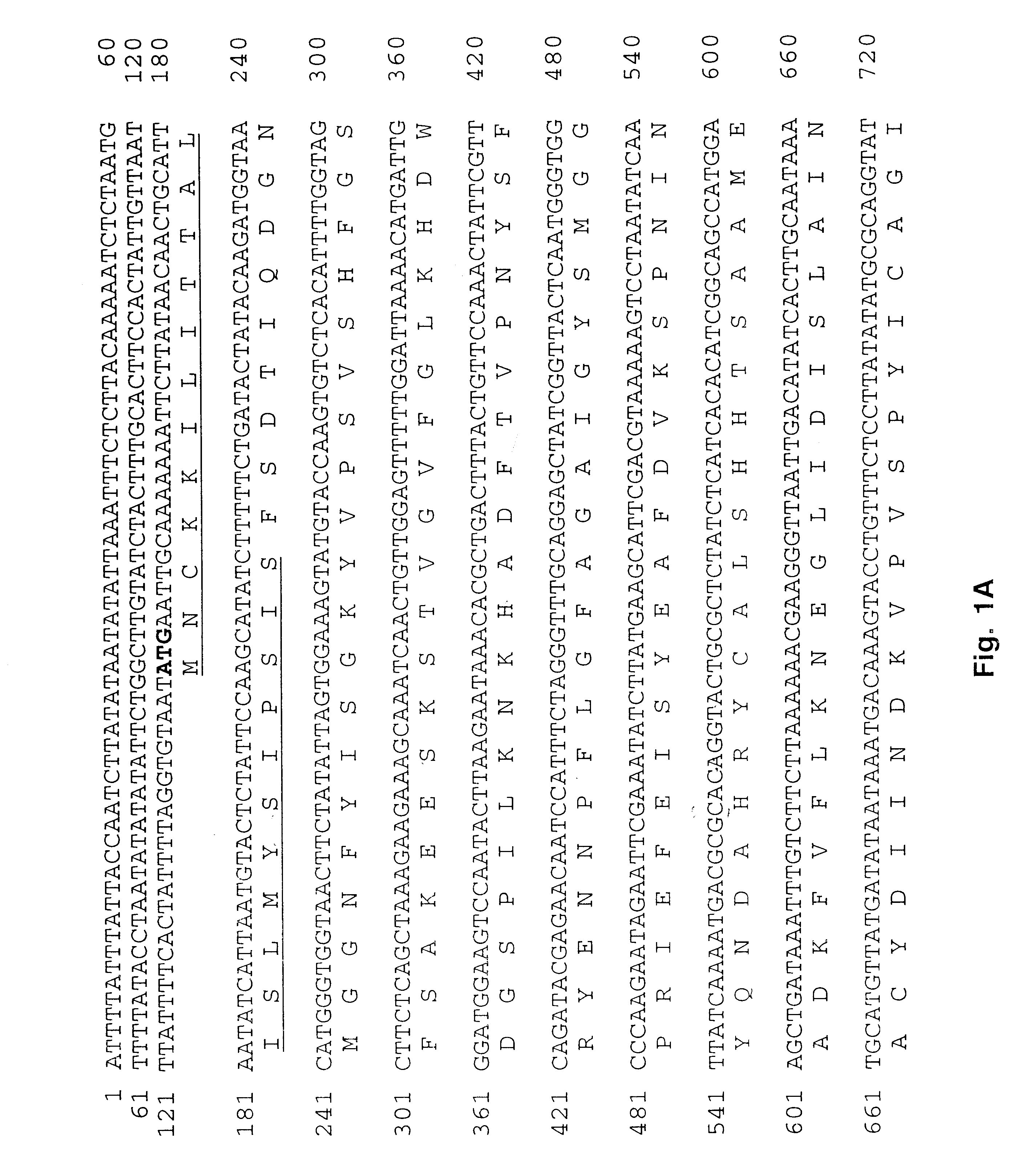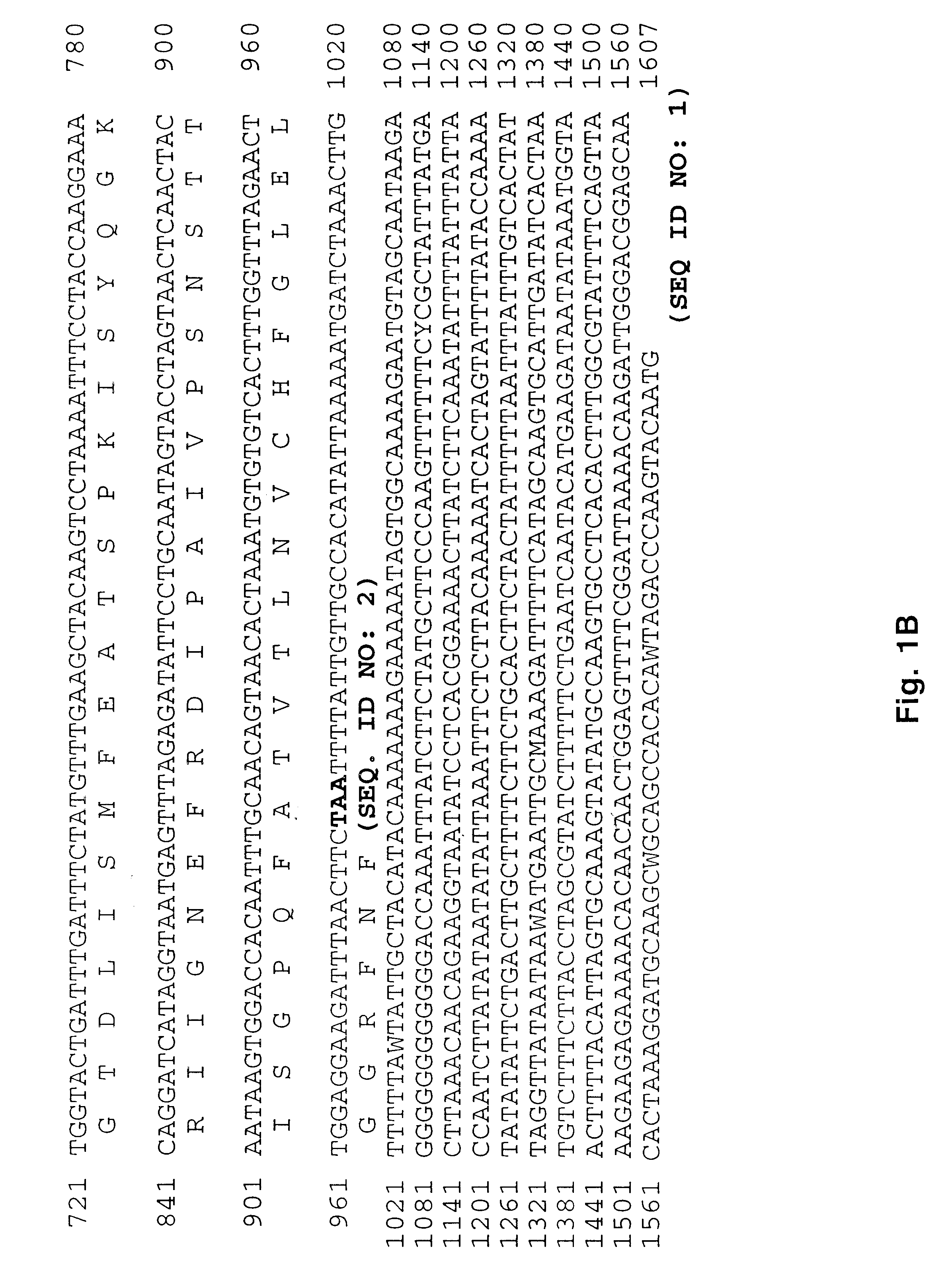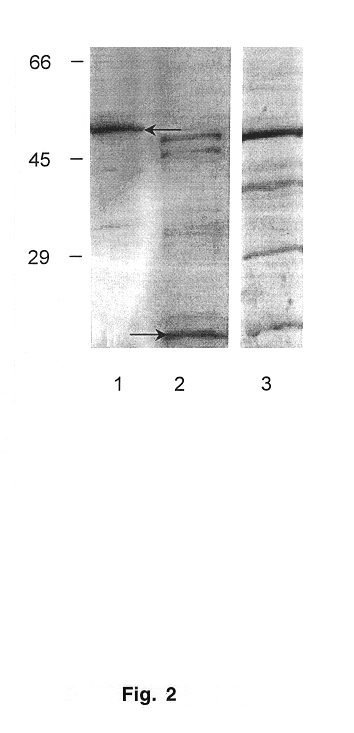Homologous 28-kilodalton immunodominant protein genes of Ehrlicha canis and uses thereof
- Summary
- Abstract
- Description
- Claims
- Application Information
AI Technical Summary
Benefits of technology
Problems solved by technology
Method used
Image
Examples
example 1
Sequencing Unknown 5' and 3' Region of the ECa28-1 (p28-7) Gene
Ehrlichia and Purification Ehrlichia canis (Florida strain and isolates Demon, DJ, Jake, and Fuzzy) were provided by Dr. Edward Breitschwerdt, (College of Veterinary Medicine, North Carolina State University, Raleigh, N.C.). E. canis (Louisiana strain) was provided by Dr. Richard E. Corstvet (School of Veterinary Medicine, Louisiana State University, Baton Rouge, La.) and E. canis (Oklahoma strain) was provided by Dr. Jacqueline Dawson (Centers for Disease Control and Prevention, Atlanta, Ga.). Propagation of Ehrlichiae was performed in DH82 cells with DMEM supplemented with 10% bovine calf serum and 2 mM L-glutamine at 37.degree. C. The intracellular growth in DH82 cells was monitored by presence of E. canis morulae using general cytologic staining methods. Cells were harvested when 100% of the cells were infected with Ehrlichiae and were then pelleted in a centrifuge at 17,000.times.g for 20 min. Cell pellets were disr...
example 2
PCR Amplification, Cloning, Sequencing and Expression of E. canis ECa28-1 (p28-7) Gene
Expression Vectors The entire E. canis p28-7 gene was PCR-amplified with primers-EC28OM-F and EC28OM-R and cloned into pCR2.1-TOPO TA cloning vector to obtain the desired set of restriction enzyme cleavage sites (Invitrogen, Carlsbad, Calif.). The insert was excised from pCR2.1-TOPO with BstX 1 and ligated into pcDNA 3.1 eukaryotic expression vector (Invitrogen, Carlsbad, Calif.) designated pcDNA3.1 / EC28 for subsequent studies. The pcDNA3.1 / EC28 plasmid was amplified, and the gene was excised with a KpnI-XbaI double digestion and directionally ligated into pThioHis prokaryotic expression vector (Invitrogen, Carlsbad, Calif.). The clone (designated pThioHis / EC28) produced a recombinant thioredoxin fusion protein in Escherichia coli BL21. The recombinant fusion protein was crudely purified in the insoluble phase by centrifugation. The control thioredoxin fusion protein was purified from soluble cell ...
example 3
Sequence Homology of E. Canis p28-7 Gene
The nucleic acid sequence of E. canis p28-7 (834-bp) and the E. chaffeensis omp-1 family of genes including signal sequences (p28-7, omp-1A, B, C, D, E, and F) were aligned using the Clustal method to examine homology between these genes (alignment not shown). Nucleic acid homology was equally conserved (68.9%) between E. canis p28-7, E. chaffeensis p28 and omp-1F. Other putative outer membrane protein genes in the E. chaffeensis omp-1 family, omp-1D (68.2%), omp-1E (66.7%), omp-1C (64.1%), Cowdria ruminantium map-1 (61.8%), E. canis 28-kDa protein 1 gene (60%) and 28-kDa protein 2 gene (partial) (59.5%) were also homologous to p28-7. E. chaffeensis omp-1B had the least nucleic acid homology (45.1%) with E. canis p28-7.
Alignment of the predicted amino acid sequences of E. canis P28-7 (SEQ ID NO. 2) and E. chaffeensis P28 revealed amino acid substitutions resulting in four variable regions (VR). Substitutions or deletions in the amino acid sequ...
PUM
| Property | Measurement | Unit |
|---|---|---|
| Length | aaaaa | aaaaa |
Abstract
Description
Claims
Application Information
 Login to View More
Login to View More - R&D
- Intellectual Property
- Life Sciences
- Materials
- Tech Scout
- Unparalleled Data Quality
- Higher Quality Content
- 60% Fewer Hallucinations
Browse by: Latest US Patents, China's latest patents, Technical Efficacy Thesaurus, Application Domain, Technology Topic, Popular Technical Reports.
© 2025 PatSnap. All rights reserved.Legal|Privacy policy|Modern Slavery Act Transparency Statement|Sitemap|About US| Contact US: help@patsnap.com



